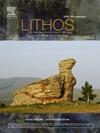哈萨克斯坦西北部Kokchetav杂岩的形成和增生演化:来自构造样式、碎屑锆石年代学和Lu-Hf同位素的见解
IF 2.9
2区 地球科学
Q2 GEOCHEMISTRY & GEOPHYSICS
引用次数: 0
摘要
了解俯冲过程是如何将大陆碎片合并成增生复合体的,对于限制增生造山带的形成具有重要意义。Kokchetav复合体是哈萨克斯坦西北部阿尔泰山脉西北部的一个独特的地质单元,是研究这些过程的理想场所。它拥有微大陆碎屑,以及增生和(超)高压([U]HP)变质岩。对Kokchetav杂岩变质沉积带、片麻岩基岩、(U)HP变质带和蛇绿质杂岩中的石英岩、片岩、片麻岩和砂岩中的碎屑锆石进行了U- pb定年和Lu-Hf同位素分析。石英片岩形成3个原生锆石年龄群:中晚古元古代(1.8 ~ 1.6 Ga)、中元古代至新元古代早期(1.4 ~ 0.8 Ga)和新元古代晚期至早泥盆世(544 ~ 406 Ma),个别锆石年龄在3.6 ~ 2.8 Ga之间。这些岩石具有不同的碎屑锆石U-Pb年龄谱(单峰-多峰)和不同的Hf同位素比值(−10.9 ~ +22.0)。锆石混合来自早古生代斯特普尼亚克弧和前寒武纪大陆碎屑,而非来自片麻岩基底,与澳大利亚元古代Musgrave-Albany造山带有密切关系。因此,这些锆石表明,在Kokchetav杂岩中存在来自Rodinia西北部超大陆的大陆碎片,该杂岩在新元古代至早古生代保持其原始性质,后来在Kokchetav微大陆与斯特普尼亚克弧的汇合过程中以构造片和构造片的形式被合并到增生杂岩中。我们的研究结果进一步表明,Kokchetav杂岩不是一个统一的前寒武纪地块的一部分,而是由早古生代超俯冲带背景下形成的大陆碎片和较年轻的增生物质组成的。本文章由计算机程序翻译,如有差异,请以英文原文为准。

Formation and accretionary evolution of the Kokchetav complex, northwestern Kazakhstan: Insights from structural styles, and detrital zircon geochronology and Lu-Hf isotopes
Understanding how subduction processes incorporate continental fragments into accretionary complexes is important for constraining the formation of accretionary orogenic belts. The Kokchetav Complex is a distinctive geological unit in the northwestern Altaids of northwestern Kazakhstan that is ideal for investigating such processes. It hosts microcontinental fragments, and accretionary and (ultra)high-pressure ([U]HP) metamorphic rocks. We undertook U-Pb dating and Lu-Hf isotopic analyses of detrital zircons from quartzites, schists, gneisses, and sandstones in the metasedimentary belt, gneissic basement rocks, (U)HP metamorphic belt, and ophiolitic mélange in the Kokchetav Complex. The quartzite–schist rocks yield three primary zircon age clusters: middle–late Paleoproterozoic (1.8–1.6 Ga), middle Mesoproterozoic to early Neoproterozoic (1.4–0.8 Ga), and latest Neoproterozoic to Early Devonian (544–406 Ma), with a few isolated zircons dated between 3.6 and 2.8 Ga. These rocks have diverse detrital zircon U-Pb age spectra (unimodal to multi-modal) with variable Hf isotope ratios (−10.9 to +22.0). The zircons have a mixed origin from the early Paleozoic Stepnyak Arc and Precambrian continental fragments, and were not derived from the gneissic basement, indicating an affinity with the Proterozoic Musgrave–Albany Orogen in Australia. Consequently, these zircons reveal that a continent fragment from the northwestern Rodinia supercontinent exists within the Kokchetav Complex, which retained its original nature from the Neoproterozoic to early Paleozoic and was later incorporated into the accretionary complex as tectonic sheets and slices during convergence between the Kokchetav microcontinent and Stepnyak Arc. Our results further indicate that, rather than being part of a unified Precambrian block, the Kokchetav Complex incorporated continental fragments and younger accreted materials that formed in an early Paleozoic supra-subduction zone setting.
求助全文
通过发布文献求助,成功后即可免费获取论文全文。
去求助
来源期刊

Lithos
地学-地球化学与地球物理
CiteScore
6.80
自引率
11.40%
发文量
286
审稿时长
3.5 months
期刊介绍:
Lithos publishes original research papers on the petrology, geochemistry and petrogenesis of igneous and metamorphic rocks. Papers on mineralogy/mineral physics related to petrology and petrogenetic problems are also welcomed.
 求助内容:
求助内容: 应助结果提醒方式:
应助结果提醒方式:


